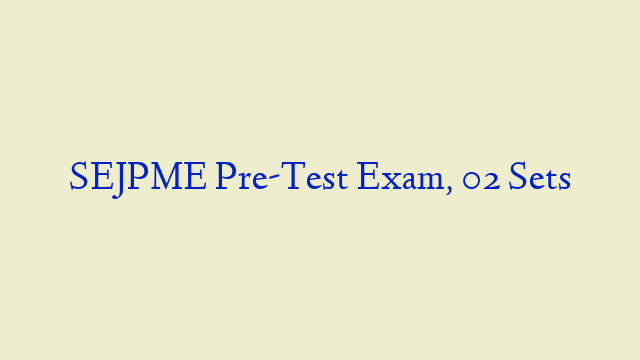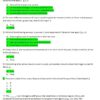Description
SEJPME Pre-Test Exam – Question and Answers
- Service members with good psychological health contribute to force readiness by being focused, alert, prepared for new tasks, able to engage in critical thinking and behave responsibly and ethically.
- The primary function of the Air Force is to provide prompt and sustained offensive and defensive air operations.
- Receiving realistic training, understanding the types of situations encountered in war, eating well, getting enough rest, and having meaningful relationships and friendships are all helpful in building _____ to the challenges and strains of military service.
- The earliest form of the Coast Guard began on 4 August 1790, when President George Washington authorized the construction of ten vessels to _____.
- The _____ outranks all other officers of the Armed Forces, but may not exercise military command over any of the Armed Forces. This officer is the principal military advisor to the President, the National Security Council, and the Secretary of Defense.
- The direction or exercise of authority over subordinate or other organizations with respect to administration and support, including organization of Service forces, control of resources and equipment, personnel management, unit logistics, individual and unit training, readiness, mobilization, demobilization, discipline, and other matters not included in the operational missions of the subordinate or other organizations is known as _____.
- Which of the following are among the Coast Guard’s roles? (Select all that apply.)
- The Chairman of the Joint Chiefs of Staff provides a channel of communication between the President/SECDEF and the combatant commanders.
- The North American Aerospace Defense Command (NORAD) is operated by which countries? (Select all that apply.)
- “The Noncommissioned Officer and Petty Officer: Backbone of the Armed Forces (2013)” states that “The ability of the NCO/PO to understand the commander’s intent, coupled with earned trust to execute it, is the foundation of _____.”
- The vetting process for participation in multinational operations serves as a mechanism to _____.
- The difficulty some units face adapting their mindset to vastly changed conditions on their third or fourth deployment to the same location is known as _____ challenges.
- While it is appropriate and strongly recommended to greet a person by name and grade, if you are unsure of an enlisted Marine’s name or grade, “Marine” is as appropriate as, “Good morning, Sir,” in the case of an officer.
- Flexibility in aerospace power allows forces to exploit mass and maneuver simultaneously to a far greater extent than surface forces can.
- U.S. Forces conduct security cooperation activities to _____.
- Historically, the practice of keeping pets onboard may have started when cats were brought on board to combat the rat population, the practice continued to help keep the crew’s morale high.
- A _____ is the principal joint Special Operations Forces organization tasked to meet all special operations requirements in major operations, campaigns, or a contingency.
- Which of the following ceremonies affirms a “leader among leaders” in the USAF, using a symbol of truth, justice, and power rightly used?
- The Joint Task Force (JTF) commander cannot dictate cooperation among other governmental agencies, intergovernmental organizations, and nongovernmental organizations. In the absence of a formal command structure, JTFs are required to build consensus to achieve _____.
- The aspect of PME that focuses on imparting joint knowledge and attitudes is joint _____.
- Between 1777 and 1778, Baron Friedrich Willhelm von Steuben taught the Continental Army what aspects of war? (Select all that apply.)
- U.S. military service is based on values that U.S. military experience has proven to be vital for operational success. These values adhere to the most idealistic societal norms, are common to all the Services, and represent the essence of military professionalism. The five values we discussed that entail “Joint Service” consist of: duty, honor, courage, integrity, and selfless service.
- What is the Army’s primary role?
- Risk assessment, risk management, and recommending mitigating measures to the commander or others, are all steps that must be taken in order to properly mitigate risk.
- Combatant commanders and subordinate joint force commanders work with U.S. ambassadors (or diplomatic missions), the Department of State, and other agencies to best integrate the military actions with the diplomatic, economic, and informational instruments of national power in order to promote _____.
- The _____ is the principal forum to advise the President with respect to the integration of domestic, foreign, and military policies relating to national security and for coordinating these policies among various government agencies.
- The Department of State assigns a ______ to combatant commanders, and increasingly to Join Task Force commanders, to provide foreign policy perspective and to establish linkage with U.S. embassies in the area of responsibility or joint operations area and the Department of State.
- There are a total of how many Reserve Components in the Armed Forces of the United States?
- The end strength of the U.S. Coast Guard Reserve is _____ percent of the total Coast Guard.
- The use of social media to conduct official government business is forbidden.
- _____ is key to successful employment, readiness, and use of Reserve Component forces.
- Within the joint environment, cooperation requires team players, and the willingness to share _____ with all team members.
- Today, the U.S. and its partners find themselves in an era in which they are unlikely to be fully at war or fully at peace.
- Which organization is the principal policy-making forum responsible for the nation’s security strategy?
- The cornerstone of ARSOAC, the _____, is organized into four like battalions and provides nighttime, all-weather, medium-range insertion, extraction, and resupply capability in hostile or denied areas.
- To reach the national strategic end state and conclude an operation successfully, commanders must integrate and synchronize stability operations with offensive and defensive operations. Planning for stability operations should begin _____.
- The Armed Forces of the U.S. conduct military operations as a _____ in which elements of two or more Military Departments participate.
- Which core value does the following tenet represent: Make decisions in the best interest of the Navy and the nation, without regard to personal consequences?
- The seizure and defense of naval bases is provided by which branch of the Armed Services?
- A group or person is honor-bound to do which of the following upon receiving a limerick at the mess?
- After the attacks of 9/11, U.S. Special Operations Command assumed an operational role in synchronizing the DoD effort in _____.
- _____ is a hostile environment that often presents complex emotional and ethical dilemmas.
- Which of the lessons learned during the Mexican War did the Union Navy use? (Select all that apply.)
- Upon a declaration of war the Coast Guard may be transferred to and operate as a service of the U.S. Navy.
- There are eight distinct domains within the Total Force Fitness (TFF) Program. Which one of the following is NOT one of the eight domains?
- Security cooperation activities include _____.
- Lt. Col. Earl H. Ellis’s post-WWI Advanced Base Operations in Micronesia 1921 document gave birth to the Marine Corps amphibious doctrine.
- Which of the following are keys to success in joint assignments? (Select all that apply.)
- Which reserve mobilization authority provides the President a means to activate, without a declaration of national emergency, not more than 200,000 reservists for not more than 365 days to meet the support requirements of any operational mission?
- Which of the following represents highlights of Air Force history?
SEJPME Pre-Test Exam 2
- The _____ is a lethal, agile, and flexible force, capable of executing a myriad of complex, joint special operations missions in support of U.S. policy and objectives.
- The relevance of the interagency process at the strategic level to the combatant commander and the U.S. military is that the process yields America’s major national security policy decisions.
- These capabilities comprise the core of U.S. maritime power and reflect an increase in emphasis on those activities that prevent war and build partnerships:
- The four categories of support are _____.
- _____ are operations that require independent actions involving a high degree of professionalism, self-discipline, flexibility, patience, and tact.
- Most special operations forces are _____-oriented. This allows them to maintain cultural awareness and language capability for their assigned areas.
- Which of the following are among the Coast Guard’s roles? (Select all that apply.)
- Which of the following represents highlights of Air Force history?
- Which of the following is NOT a member of the Joint Chiefs of Staff?
- Commonly used terms under the multinational rubric include all of the following terms, except:
- The most recent time the Coast Guard was called into service and deployed in wartime was?
- During the Total Force Fitness ((TFF) Program section of the course, we discussed the importance of leader involvement. Leaders must identify the metrics that will set the right conditions to promote total fitness. In order to accurately assess the TFF program’s effectiveness, metrics must be _____ .
- Under what circumstances may the Coast Guard be transferred to and operate as a service of the Navy? (Select all that apply.)
- Which of the following are examples of naval implementation of the U.S. Containment Policy? (Select all that apply.)
- Which of the following is NOT one of the major levels of reserve mobilization?
- Flexibility in aerospace power allows forces to exploit mass and maneuver simultaneously to a far greater extent than surface forces can.
- Leaders in a joint environment have no reason to be familiar with the rules and regulations concerning maintaining good order and discipline within their commands including the punitive articles of the Uniform Code of Military Justice.
- The primary responsibilities of the Air Force Reserve Components, the Air Force Reserve, and the Air National Guard include airlift and air refueling.
- Reserve Components now comprise almost what percent of the Total Force and are an integral part of the Armed Forces of the United States?
- The _____, signed by the Chairman of the Joint Chiefs of Staff, provides guidance for distributing and applying military power to attain national strategic objectives. It describes the Armed Force’s plan to achieve military objectives in the near term and provides the vision for ensuring they remain decisive in the future.
- The purpose of the _____ principle of joint operations is to prepare clear, uncomplicated plans and concise orders to ensure thorough understanding.
- Operations that are typically limited in scope and scale and conducted to achieve a very specific objective in an operational area are known as _____.
- The offering of ceremonial toasts is a traditional Army custom at a formal Dining-In, which includes passing the wine, “over the water,” a historical reference to King James I, who was exiled by Oliver Cromwell.
- The ______ is an interagency staff group that establishes or enhances regular, timely, and collaborative working relationships between other government agency (e.g., CIA, DOS, FBI) representatives and military operational planners at the combatant commands.
- The pinning ceremony signifies which of the following?
- Receiving realistic training, understanding the types of situations encountered in war, eating well, getting enough rest, and having meaningful relationships and friendships are all helpful in building _____ to the challenges and strains of military service.
- The National Security Council comprises of which three levels of formal interagency committees for coordination and making decisions on national security issues?
- Which of the following are the roles of the Marine Corps according to Title 10 US Code?
- Which of the following are keys to success in joint assignments? (Select all that apply.)
- Lt. Col. Earl H. Ellis’s post-WWI Advanced Base Operations in Micronesia 1921 document gave birth to the Marine Corps’ amphibious doctrine.
- The interagency support provided by a _____, composed of intelligence experts from DIA, CIA, NSA, NGA, and other intelligence agencies, affords the Joint Task Force access to national-level databases and to agency-unique information and analysis.
- Which of the following are among Air Force customs, courtesies, and traditions designed to provide high morale? (Select all that apply.)
- Recognizing potentially hazardous or negative situations in advance is crucial to being prepared to prevent them from occurring to begin with. With experience and maturity, the ability to instinctually recognize signs of potential trouble increases.
- The need for effective liaison is vital in any multinational force because _____.
- Successful teamwork in the joint environment requires trust, confidence and _____.
- Reserve Component leaders agree that they receive adequate funding to support all levels of operational use identified by Service and Department of Defense plans.
- Each geographic combatant command has a _____ to plan and control special operations and other Special Operations Forces activities.
- The primary function of the Air Force is to provide prompt and sustained offensive and defensive air operation.
- During the ceremony of the Ancient Mariner, the new Ancient Mariner must wear _____. (Select all that apply.)
- It is essential that leaders ensure that service members understand the availability of psychological health resources and support and encourage the use of those resources as needed.
- Which of the following are among Marine Corps customs, courtesies and traditions? (Select all that apply.)
- The DoD Reorganization Act of 1958 _____.
- What are the Army’s primary missions? (Select all that apply.)
- Regardless of when or where employed, the Armed Forces of the United States abide by U.S. values, the standards for the profession of arms, and _____.
- The U.S. Army was originally formed to fight in which war?
- The difficulty some units face adapting their mindset to vastly changed conditions on their third or fourth deployment to the same location is known as _____ challenges.
- Factors affecting the military capabilities of nations include _____.
- The Noncommissioned Officer and Petty Officer: Backbone of the Armed Forces (2013)” states that, “The officer-NCO/PO relationship is a sacred feature in the Profession of Arms. It is built on mutual recognition of their _____, and a true appreciation of the contribution of each.”
- Which organization monitors suspected drug trafficking aircraft and maritime vessels?
- Joint _____ prepares individual members and units of the Armed Forces to field a joint force that integrates service capabilities in order to execute assigned missions.






